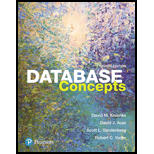
Database Concepts (8th Edition)
8th Edition
ISBN: 9780134601533
Author: David M. Kroenke, David J. Auer, Scott L. Vandenberg, Robert C. Yoder
Publisher: PEARSON
expand_more
expand_more
format_list_bulleted
Expert Solution & Answer
Chapter 7, Problem 7.1RQ
Explanation of Solution
Web based application in three-tier Architecture:
In web based environment, a Web server and the DBMS (
- The major components of web database applications are web browser, web server and database.
The below diagram will illustrate the three-tier architecture as follows:

The layers in the three-tier architecture are listed below:
- Application (web browser)
- Web server
- DBMS server
Application (web browser):
- Applications are developed using scripting language which executes on computers.
- It will send a web page request to the web server.
Web server:
- Server scripting code is used to control the code which returns back to the browser.
- It will send a database request to the DBMS server.
DBMS server:
- Results from databases are made by sending request for DBMS operations using SQL and SQL/PSM commands.
Want to see more full solutions like this?
Subscribe now to access step-by-step solutions to millions of textbook problems written by subject matter experts!
Students have asked these similar questions
Explain the concept of sharding in the context of database architecture.
Explain the concept of sharding in distributed database architectures.
Describe the concept of sharding in the context of database architecture.
Chapter 7 Solutions
Database Concepts (8th Edition)
Ch. 7 - Prob. 7.1RQCh. 7 - Prob. 7.2RQCh. 7 - Prob. 7.3RQCh. 7 - Prob. 7.4RQCh. 7 - Prob. 7.5RQCh. 7 - Prob. 7.6RQCh. 7 - Prob. 7.7RQCh. 7 - Prob. 7.8RQCh. 7 - Prob. 7.9RQCh. 7 - Prob. 7.10RQ
Ch. 7 - Prob. 7.11RQCh. 7 - Prob. 7.12RQCh. 7 - Prob. 7.13RQCh. 7 - Prob. 7.14RQCh. 7 - Prob. 7.15RQCh. 7 - Prob. 7.16RQCh. 7 - Prob. 7.17RQCh. 7 - Prob. 7.18RQCh. 7 - Prob. 7.19RQCh. 7 - Prob. 7.20RQCh. 7 - Prob. 7.21RQCh. 7 - Prob. 7.22RQCh. 7 - Prob. 7.23RQCh. 7 - Prob. 7.24RQCh. 7 - Prob. 7.25RQCh. 7 - Prob. 7.26RQCh. 7 - Prob. 7.27RQCh. 7 - Prob. 7.28RQCh. 7 - Prob. 7.29RQCh. 7 - Prob. 7.30RQCh. 7 - Prob. 7.31RQCh. 7 - Prob. 7.32RQCh. 7 - Prob. 7.33RQCh. 7 - Prob. 7.34RQCh. 7 - Prob. 7.35RQCh. 7 - Prob. 7.36RQCh. 7 - Show a snippet of PHP code for creating a...Ch. 7 - Show a snippet of PHP code for displaying the...Ch. 7 - Show a snippet of PHP code for disconnecting from...Ch. 7 - Prob. 7.40RQCh. 7 - Prob. 7.41RQCh. 7 - Prob. 7.42RQCh. 7 - Prob. 7.43RQCh. 7 - Prob. 7.44RQCh. 7 - Prob. 7.45RQCh. 7 - Prob. 7.46RQCh. 7 - Prob. 7.47RQCh. 7 - What is the purpose of the FOR XML expression in...Ch. 7 - Prob. 7.49RQCh. 7 - Prob. 7.50RQ
Knowledge Booster
Similar questions
- Describe the different types of database requests and transactions.arrow_forwardSQL databases conform to ACID properties. Briefly describe the ACID properties, and state the purpose of each. How does conformance to ACID properties affect the performance of SQL databases?arrow_forwardDescribe the role of ACID and BASE principles in different database architectures.arrow_forward
- Explain the concept of distributed transactions and the importance of ACID properties in a distributed database environment.arrow_forwardDescribe the challenges and benefits of sharding in distributed database systems.arrow_forwardExplain three-schema Architecture for Database Development?arrow_forward
- Describe the concept of transaction isolation levels and their significance in a database environment.arrow_forwardExplain the concept of sharding in a distributed database system. How does sharding improve scalability and performance?arrow_forwardDescribe the CAP theorem and how it relates to distributed database architectures.arrow_forward
- Explain the concept of microservices architecture and its implications for database design and management.arrow_forwardExplain the concept of data migration in a distributed database environment. What factors influence the decision to migrate data between nodes?arrow_forwardExplain the key characteristics and use cases of the following database architectures: Columnar, Document, Key-Value, and Graph databases.arrow_forward
arrow_back_ios
SEE MORE QUESTIONS
arrow_forward_ios
Recommended textbooks for you
 Database Systems: Design, Implementation, & Manag...Computer ScienceISBN:9781305627482Author:Carlos Coronel, Steven MorrisPublisher:Cengage Learning
Database Systems: Design, Implementation, & Manag...Computer ScienceISBN:9781305627482Author:Carlos Coronel, Steven MorrisPublisher:Cengage Learning Principles of Information Systems (MindTap Course...Computer ScienceISBN:9781305971776Author:Ralph Stair, George ReynoldsPublisher:Cengage Learning
Principles of Information Systems (MindTap Course...Computer ScienceISBN:9781305971776Author:Ralph Stair, George ReynoldsPublisher:Cengage Learning Principles of Information Systems (MindTap Course...Computer ScienceISBN:9781285867168Author:Ralph Stair, George ReynoldsPublisher:Cengage Learning
Principles of Information Systems (MindTap Course...Computer ScienceISBN:9781285867168Author:Ralph Stair, George ReynoldsPublisher:Cengage Learning Enhanced Discovering Computers 2017 (Shelly Cashm...Computer ScienceISBN:9781305657458Author:Misty E. Vermaat, Susan L. Sebok, Steven M. Freund, Mark Frydenberg, Jennifer T. CampbellPublisher:Cengage Learning
Enhanced Discovering Computers 2017 (Shelly Cashm...Computer ScienceISBN:9781305657458Author:Misty E. Vermaat, Susan L. Sebok, Steven M. Freund, Mark Frydenberg, Jennifer T. CampbellPublisher:Cengage Learning Fundamentals of Information SystemsComputer ScienceISBN:9781337097536Author:Ralph Stair, George ReynoldsPublisher:Cengage Learning
Fundamentals of Information SystemsComputer ScienceISBN:9781337097536Author:Ralph Stair, George ReynoldsPublisher:Cengage Learning

Database Systems: Design, Implementation, & Manag...
Computer Science
ISBN:9781305627482
Author:Carlos Coronel, Steven Morris
Publisher:Cengage Learning

Principles of Information Systems (MindTap Course...
Computer Science
ISBN:9781305971776
Author:Ralph Stair, George Reynolds
Publisher:Cengage Learning

Principles of Information Systems (MindTap Course...
Computer Science
ISBN:9781285867168
Author:Ralph Stair, George Reynolds
Publisher:Cengage Learning

Enhanced Discovering Computers 2017 (Shelly Cashm...
Computer Science
ISBN:9781305657458
Author:Misty E. Vermaat, Susan L. Sebok, Steven M. Freund, Mark Frydenberg, Jennifer T. Campbell
Publisher:Cengage Learning

Fundamentals of Information Systems
Computer Science
ISBN:9781337097536
Author:Ralph Stair, George Reynolds
Publisher:Cengage Learning
